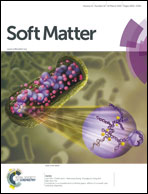Design of a robust superhydrophobic surface: thermodynamic and kinetic analysis†
Abstract
The design of a robust superhydrophobic surface is a widely pursued topic. While many investigations are limited to applications with high impact velocities (for raindrops of the order of a few meters per second), the essence of robustness is yet to be analyzed for applications involving quasi-static liquid transfer. To achieve robustness with high impact velocities, the surface parameters (geometrical details, chemistry) have to be selected from a narrow range of permissible values, which often entail additional manufacturing costs. From the dual perspectives of thermodynamics and mechanics, we analyze the significance of robustness for quasi-static drop impact, and present the range of permissible surface characteristics. For surfaces with a Young's contact angle greater than 90° and square micropillar geometry, we show that robustness can be enforced when an intermediate wetting state (sagged state) impedes transition to a wetted state (Wenzel state). From the standpoint of mechanics, we use available scientific data to prove that a surface with any topology must withstand a pressure of 117 Pa to be robust. Finally, permissible values of surface characteristics are determined, which ensure robustness with thermodynamics (formation of a sagged state) and mechanics (withstanding 117 Pa).


 Please wait while we load your content...
Please wait while we load your content...